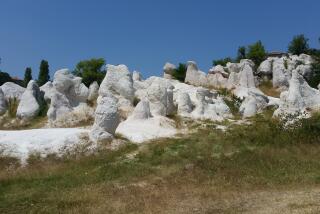Archeology as Metaphor for Analysis? : Therapy: Freud’s obsession with artifacts echoed his belief that each individual relives the history of the human race.
- Share via
No patient today--accustomed to the soothing pictures of pastoral vistas or serene ocean views in a psychologist’s office--would be prepared for what he or she saw when walking into Sigmund Freud’s consulting room at Berggasse 19 in Vienna. Wherever the gaze rested--on table tops, in book cases, in glassed-in cabinets--stood hundreds of ancient bronze and terra-cotta figurines of gods and ancient vases from Egypt, Greece and the Far East. Egyptian and Roman wall paintings representing scenes of long-vanished epochs crowded the walls. A Persian rug and pillows of warm, solid colors covered the famed couch. On the wall behind the couch, another Persian rug and a large color print of Ramses II’s temple at Abu Simbel with its colossal seated deities emerging out of the living rock, a plaster cast of the classical Greek relief of the girl known as Gradiva and a reproduction of Ingres’ painting of Oedipus interrogating the Sphinx greeted the patient. It was not a room one would soon forget. As one of Freud’s analysands remarked, “There was always a feeling of sacred peace and quiet . . . (reminiscent not so much of) a doctor’s office but rather of an archeologist’s study.”
Freud’s obsession with collecting art can be dated to Dec. 6, 1896, two months after his father’s death, when, at 40, he began decorating his first office at his home at Berggasse 19. He was also on the verge of beginning his own self-analysis. His first pieces were reproductions of Florentine statues, sources of “extraordinary refreshment” as he called them. By the time he moved his office to the second floor in 1907, Freud’s interest in Renaissance art had given way to an abiding desire to buy only original statues and those of the greatest antiquity. By 1938, more than 2,000 ancient objects, almost half of them from Egypt, lined his consulting room and adjoining inner sanctum or study. The relatively small but always neat writing desk in the study was hemmed in with a rampart of ancient figures in rows two or three deep. Again, most were of Egyptian gods, but front and center was Freud’s most prized possession: a Roman bronze of Athena, one arm raised to hold a spear. Showing this to a patient, he commented, “This is my favorite. She is perfect, only she has lost her spear.”
Freud’s relation to these objects was far from simple. In his own efforts to unearth and reconstruct meaning from a fragmentary past, Freud regarded archeology as a master metaphor for psychoanalysis and saw himself in his excavations of the mind as a second Schiemann who “had dug up another Troy which had hitherto been believed to be mythical.” Today, the metaphor of the past as an artifact that can be recovered out of the ground is suspect as we have come to see that the past itself is constantly susceptible to reinterpretation. But for Freud, the analogy was deeply felt as he saw himself bringing to the light of day the priceless, if often mutilated, relics of antiquity.
But these objects in his study were more than metaphor for a new science. While never making intelligible the biological or psychological truth of these claims, Freud believed that each individual relives the history of the human race. In his theory, fantasies, dreams and neuroses preserve mental antiquities and may even record what were once real occurrences in the primeval times of the human family; equally, his library of artifacts from the earliest civilizations provided tangible access to the primitive stages of our mental life. If his antiquities were guideposts for an inquiring scientist, they also possessed totemic power. At two points in his life, he deliberately broke a statue: Once to help heal his gravely ill eldest child; another time to repair a threatened friendship.
Freud also brought his collection into the therapeutic process. He was known to turn some of the ancient pieces over in his hands while talking to his patients (but not while listening) or would illustrate his remarks by pointing to them. As he fancied himself an Oedipus, defeating the dark riddling voices of the subconscious, so he hoped that his artifacts would be no less eloquent for his analysands. In his rooms of antiquities, the ancient stones with their silent voice would challenge the 20th-Century patient to (re)discover not only the layered history of his or her past, but also the more remote, unsublimated impulses of our collective childhood. In his room, archeology invites psychoanalysis. Looking over from the couch to a portrait of the Sphinx of Giza, an analysand was facing the riddle of his or her recovery, as if unearthing the clues of the enigma were the means to self-understanding and health.






